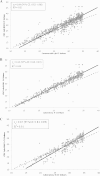Evaluation of Level of Agreement in Bordetella Species Identification in Three U.S. Laboratories during a Period of Increased Pertussis
- PMID: 25809969
- PMCID: PMC4432061
- DOI: 10.1128/JCM.03567-14
Evaluation of Level of Agreement in Bordetella Species Identification in Three U.S. Laboratories during a Period of Increased Pertussis
Abstract
While PCR is the most common method used for detecting Bordetella pertussis in the United States, most laboratories use insertion sequence 481 (IS481), which is not specific for B. pertussis; therefore, the relative contribution of other Bordetella species is not understood. The objectives of this study were to evaluate the proportion of other Bordetella species misidentified as B. pertussis during a period of increased pertussis incidence, determine the level of agreement in Bordetella species detection between U.S. commercial laboratories and the CDC, and assess the relative diagnostic sensitivity of CDC's PCR assay when using a different PCR master mix. Specimens collected between May 2012 and May 2013 were tested at two U.S. commercial laboratories for B. pertussis and B. parapertussis detection. Every fifth specimen positive for IS481 and/or IS1001 with cycle threshold (CT) values of ≤35 was sent to CDC for PCR testing that identifies Bordetella species. Specimens with indeterminate or negative results in the CDC PCR were tested using an alternate PCR master mix. Of 755 specimens, there was agreement in species identification for 83.4% (n = 630). Of the specimens with different identifications (n = 125), 79.2% (n = 99) were identified as indeterminate B. pertussis at CDC. Overall, 0.66% (n = 5) of the specimens were identified as B. holmesii or B. bronchiseptica at CDC. Of 115 specimens with indeterminate or negative results, 46.1% (n = 53) were B. pertussis positive when tested by an alternate master mix, suggesting a possible increase in assay sensitivity. This study demonstrates good agreement between the two U.S. commercial laboratories and CDC and little misidentification of Bordetella species during the 2012 U.S. epidemic.
Copyright © 2015, American Society for Microbiology. All Rights Reserved.
Figures

Similar articles
-
Comparison of Bordetella species identification among differing rt-PCR assays in the United States.Microbiol Spectr. 2024 Aug 6;12(8):e0078324. doi: 10.1128/spectrum.00783-24. Epub 2024 Jul 9. Microbiol Spectr. 2024. PMID: 38980022 Free PMC article.
-
Multiplex LightCycler PCR assay for detection and differentiation of Bordetella pertussis and Bordetella parapertussis in nasopharyngeal specimens.J Clin Microbiol. 2002 Jan;40(1):96-100. doi: 10.1128/JCM.40.1.96-100.2002. J Clin Microbiol. 2002. PMID: 11773099 Free PMC article.
-
Do not let perfect be the enemy of good: the current reality of Bordetella testing.Microbiol Spectr. 2025 Jan 7;13(1):e0221024. doi: 10.1128/spectrum.02210-24. Epub 2024 Dec 9. Microbiol Spectr. 2025. PMID: 39651857 Free PMC article.
-
Pertussis: relevant species and diagnostic update.Clin Lab Med. 2014 Jun;34(2):237-55. doi: 10.1016/j.cll.2014.02.003. Epub 2014 Apr 12. Clin Lab Med. 2014. PMID: 24856526 Review.
-
Other Bordetellas, lessons for and from pertussis vaccines.Expert Rev Vaccines. 2014 Sep;13(9):1125-33. doi: 10.1586/14760584.2014.942221. Epub 2014 Jul 18. Expert Rev Vaccines. 2014. PMID: 25034039 Review.
Cited by
-
Laboratory Diagnosis of Pertussis.Clin Microbiol Rev. 2015 Oct;28(4):1005-26. doi: 10.1128/CMR.00031-15. Clin Microbiol Rev. 2015. PMID: 26354823 Free PMC article. Review.
-
Evaluation of Commercial Assays for Single-Point Diagnosis of Pertussis in the US.J Pediatric Infect Dis Soc. 2017 Sep 1;6(3):e15-e21. doi: 10.1093/jpids/piw035. J Pediatric Infect Dis Soc. 2017. PMID: 27451419 Free PMC article.
-
Virus Coinfection is a Predictor of Radiologically Confirmed Pneumonia in Children with Bordetella pertussis Infection.Infect Dis Ther. 2021 Mar;10(1):335-346. doi: 10.1007/s40121-020-00376-5. Epub 2020 Dec 3. Infect Dis Ther. 2021. PMID: 33270206 Free PMC article.
-
Pertussis resurgence: epidemiological trends, pathogenic mechanisms, and preventive strategies.Front Immunol. 2025 Jul 10;16:1618883. doi: 10.3389/fimmu.2025.1618883. eCollection 2025. Front Immunol. 2025. PMID: 40709171 Free PMC article. Review.
-
Laboratory-based surveillance of pertussis using multitarget real-time PCR in Japan: evidence for Bordetella pertussis infection in preteens and teens.New Microbes New Infect. 2015 Oct 22;8:70-4. doi: 10.1016/j.nmni.2015.10.001. eCollection 2015 Nov. New Microbes New Infect. 2015. PMID: 27076914 Free PMC article.
References
-
- Centers for Disease Control and Prevention (CDC). 2012. Pertussis epidemic–Washington, 2012. MMWR Morb Mortal Wkly Rep 61(28):517–522. - PubMed
-
- Centers for Disease Control and Prevention (CDC). 2014. Summary of notifiable diseases: United States, 2012. MMWR Morb Mortal Wkly Rep 61(53):1–121. - PubMed
-
- Parkhill J, Sebaihia M, Preston A, Murphy LD, Thomson N, Harris DE, Holden MTG, Churcher CM, Bentley SD, Mungall KL, Cerdeno-Tarraga AM, Temple L, James K, Harris B, Quail MA, Achtman M, Atkin R, Baker S, Basham D, Bason N, Cherevach I, Chillingworth T, Collins M, Cronin A, Davis P, Doggett J, Feltwell T, Goble A, Hamlin N, Hauser H, Holroyd S, Jagels K, Leather S, Moule S, Norberczak H, O'Neil S, Ormond D, Price C, Rabbinowitsch E, Rutter S, Sanders M, Saunders D, Seeger K, Sharp S, Simmonds M, Skelton J, Squares R, Squares S, Stevens K, Unwin L, Whitehead S, Barrell BG, Maskell DJ. 2003. Comparative analysis of the genome sequences of Bordetella pertussis, Bordetella parapertussis and Bordetella bronchiseptica. Nat Genet 35:32–40. doi:10.1038/ng1227. - DOI - PubMed
-
- Harvill ET, Goodfield LL, Ivanov Y, Meyer JA, Newth C, Cassiday P, Tondella ML, Liao P, Zimmerman J, Meert K, Wessel D, Berger J, Dean JM, Holubkov R, Burr J, Liu T, Brinkac L, Kim M, Losada L. 2013. Genome sequences of 28 Bordetella pertussis U.S. outbreak strains dating from 2010 to 2012. Genome Announc 1(6):e01075-13. doi:10.1128/genomeA.01075-13. - DOI - PMC - PubMed
MeSH terms
LinkOut - more resources
Full Text Sources

